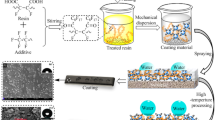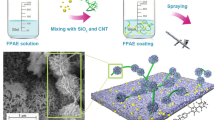Abstract
A large number of studies have attempted to fabricate superhydrophobic surface with micro-nano hierarchical structure on the surface of polytetrafluoroethylene (PTFE). However, the tough crystalline structure and extremely high viscosity of PTFE bring great challenges in the practical processing and industries application. In this study, we aim to fabricate superhydrophobic surface with micro-nano hierarchical structure on PTFE/graphite composite surface using hot embossing process. The as-fabricated superhydrophobic surface possesses micro-scale protrusion, nano-scale structures, and submicron fibers between the protrusions. The formation mechanism of the micro-nano hierarchical structure was analyzed numerically, and the superhydrophobicity of the embossed surfaces under different conditions was investigated experimentally. The superhydrophobic performance is fully realized at the process condition of temperature range of 210 ~ 250℃ and an embossing time of above 5 min. The impact of hot embossing process conditions on the height of protrusion and static contact angle was also analyzed. The maximum static contact angle was measured as 160.7°. Subsequently, by comparing the impact dynamics of droplets on PTFE and PTFE/ graphite composite surfaces, it is verified that PTFE/ graphite composite shows superior hydrophobicity.







Similar content being viewed by others
Data availability
Not applicable.
Code availability
Not applicable.
References
Feng L, Li S, Li Y et al (2002) Super-hydrophobic surfaces: From natural to artificial. Adv Mater 14:1857–1860. https://doi.org/10.1002/adma.200290020
Lafuma A, Quéré D (2003) Superhydrophobic states. Nat Mater 2:457–460. https://doi.org/10.1038/nmat924
Tuteja A, Choi W, Ma M et al (2007) Designing superoleophobic surfaces. Science 318:1618–1622. https://doi.org/10.1126/science.1148326
Xu S, Wang Q, Wang N, Zheng X (2019) Fabrication of superhydrophobic green surfaces with good self-cleaning, chemical stability and anti-corrosion properties. J Mater Sci 54:13006–13016. https://doi.org/10.1007/s10853-019-03789-x
Wu Z, Bao H, Xing Y, Liu L (2021) Tribological characteristics and advanced processing methods of textured surfaces: a review. Int J Adv Manuf Tech 114:1241–1277. https://doi.org/10.1007/s00170-021-06954-2
Li XM, Reinhoudt D, Crego-Calama M (2007) What do we need for a superhydrophobic surface? A review on the recent progress in the preparation of superhydrophobic surfaces. Chem Soc Rev 36:1350–1368. https://doi.org/10.1039/b602486f
Zhang X, Shi F, Niu J et al (2008) Superhydrophobic surfaces: From structural control to functional application. J Mater Chem 18:621–633. https://doi.org/10.1039/b711226b
Roach P, Shirtcliffe NJ, Newton MI (2008) Progess in superhydrophobic surface development. Soft Matter 4:224. https://doi.org/10.1039/b712575p
Maghsoudi K, Momen G, Jafari R, Farzaneh M (2018) Direct replication of micro-nanostructures in the fabrication of superhydrophobic silicone rubber surfaces by compression molding. Appl Surf Sci 458:619–628. https://doi.org/10.1016/j.apsusc.2018.07.099
Shiu JY, Kuo CW, Chen P, Mou CY (2004) Fabrication of Tunable Superhydrophobic Surfaces by Nanosphere Lithography. Chem Mater 16:561–564. https://doi.org/10.1021/cm034696h
Maghsoudi K, Vazirinasab E, Momen G, Jafari R (2020) Advances in the Fabrication of Superhydrophobic Polymeric Surfaces by Polymer Molding Processes. Ind Eng Chem Res 59:9343–9363. https://doi.org/10.1021/acs.iecr.0c00508
Yeong YH, Gupta MC (2017) Hot embossed micro-textured thin superhydrophobic Teflon FEP sheets for low ice adhesion. Surf Coat Tech 313:17–23. https://doi.org/10.1016/j.surfcoat.2017.01.026
Toosi SF, Moradi S, Ebrahimi M, Hatzikiriakos SG (2016) Microfabrication of polymeric surfaces with extreme wettability using hot embossing. Appl Surf Sci 378:426–434. https://doi.org/10.1016/j.apsusc.2016.03.116
Choi D, Yoo D, Kim DS (2015) One-Step Fabrication of Transparent and Flexible Nanotopographical-Triboelectric Nanogenerators via Thermal Nanoimprinting of Thermoplastic Fluoropolymers. Adv Mater 27:7386–7394. https://doi.org/10.1002/adma.201503802
Ranjbarzadeh-Dibazar A, Shokrollahi P, Barzin J, Rahimi A (2014) Lubricant facilitated thermo-mechanical stretching of PTFE and morphology of the resulting membranes. J Membrane Sci 470:458–469. https://doi.org/10.1016/j.memsci.2014.07.062
Jucius D, Grigalinas V, Mikolajnas M et al (2011) Hot embossing of PTFE: Towards superhydrophobic surfaces. Appl Surf Sci 257:2353–2360. https://doi.org/10.1016/j.apsusc.2010.09.102
Victor JJ, Facchini D, Erb U (2012) A low-cost method to produce superhydrophobic polymer surfaces. J Mater Sci 47:3690–3697. https://doi.org/10.1007/s10853-011-6217-x
Kolew A, Münch D, Sikora K, Worgull M (2011) Hot embossing of micro and sub-micro structured inserts for polymer replication. Microsyst Technol 17:609–618. https://doi.org/10.1007/s00542-010-1182-x
Gong D, Long J, Fan P et al (2015) Thermal stability of micro-nano structures and superhydrophobicity of polytetrafluoroethylene films formed by hot embossing via a picosecond laser ablated template. Appl Surf Sci 331:437–443. https://doi.org/10.1016/j.apsusc.2015.01.102
Moon IY, Lee HW, Oh YS et al (2019) Characterization of microfibril development on PTFE surface during hot imprinting process and its application for oil–water separation. Int J Adv Manuf Tech 102:1871–1883. https://doi.org/10.1007/s00170-019-03303-2
Moon IY, Kim BH, Lee HW et al (2020) Superhydrophobic Polymer Surface with Hierarchical Patterns Fabricated in Hot Imprinting Process. Int J Pr Eng Man- GT 7:493–503. https://doi.org/10.1007/s40684-019-00094-5
Barylski A, Swinarew AS, Aniołek K et al (2020) Tribological and mechanical behavior of graphite composites of polytetrafluoroethylene (PTFE) irradiated by the electron beam. Polymers 12:1–13. https://doi.org/10.3390/POLYM12081676
Stan F, Fetecau C (2013) Study of stress relaxation in polytetrafluoroethylene composites by cylindrical macroindentation. Compos Part B-Eng 47:298–307. https://doi.org/10.1016/j.compositesb.2012.11.008
Tóth LF, Baets PD, Szebényi G (2020) Thermal, Viscoelastic, Mechanical and Wear Behaviour of Nanoparticle Filled Polytetrafluoroethylene: A Comparison. Polymers 12:1940. https://doi.org/10.3390/polym12091940
Elleb R, Engel T, Antoni F et al (2021) Study of femtosecond laser multi-scale textured steel surfaces on the wettability in relation to aging. J Mater Sci 56:20169–20180. https://doi.org/10.1007/s10853-021-06574-x
Feng X, Jiang L (2006) Design and creation of superwetting/antiwetting surfaces. Adv Mater 18:3063–3078. https://doi.org/10.1002/adma.200501961
Puukilainen E, Rasilainen T, Suvanto M, Pakkanen TA (2007) Superhydrophobic polyolefin surfaces: Controlled micro- and nanostructures. Langmuir 23:7263–7268. https://doi.org/10.1021/la063588h
Liu C, Li JM, Liang Y et al (2010) Filling modes of polymer during submicron and nano-fabrication near glass transition temperature. J Mater Process Tech 210:696–702. https://doi.org/10.1016/j.jmatprotec.2009.12.008
Bhushan B, Jung YC (2011) Natural and biomimetic artificial surfaces for superhydrophobicity, self-cleaning, low adhesion, and drag reduction. Prog in Mater Sci 56:1–108. https://doi.org/10.1016/j.pmatsci.2010.04.003
Funding
This research was supported by the foundation for the construction of first-class research institutes in China by the Guangdong Academy of Sciences (grant numbers 2021GDASYL-20210103029, 2021GDASYL-20210302002, 2018GDASCX-0103) and the Natural Science Foundation of Guangdong Province (grant numbers 2019A1515011655). BL acknowledges the financial supports by Sichuan Science and Technology Program (Grant No. 2022NSFSC1989).
Author information
Authors and Affiliations
Contributions
Yao Gong: Experiments, Simulation, Formal analysis, Methodology, Writing-original draft; Bin Li: Methodology, Validation, Writing-review & editing; Longsheng Chen and Qian Lv: Methodology, Validation; Qingran Wang: Modified draft, Validation; Wankun Liu: Methodology, Formal analysis; Lili Zou: Founding acquision, Con-ceptualization, Writing-review & editing.
Corresponding author
Ethics declarations
Ethics approval
Not applicable.
Consent to participate
All authors have declared their approval to manuscript submission.
Consent for publication
All authors have given their permission for publishing this work.
Competing interest
The authors declare no conflicts of interest.
Additional information
Publisher's Note
Springer Nature remains neutral with regard to jurisdictional claims in published maps and institutional affiliations.
Supplementary Information
Below is the link to the electronic supplementary material.
Supplementary file1 (AVI 3485 KB)
Supplementary file2 (AVI 3489 KB)
Rights and permissions
Springer Nature or its licensor (e.g. a society or other partner) holds exclusive rights to this article under a publishing agreement with the author(s) or other rightsholder(s); author self-archiving of the accepted manuscript version of this article is solely governed by the terms of such publishing agreement and applicable law.
About this article
Cite this article
Gong, Y., Li, B., Chen, L. et al. Study on superhydrophobicity of hot embossed polytetrafluoroethylene/graphite composites. J Polym Res 30, 168 (2023). https://doi.org/10.1007/s10965-023-03539-3
Received:
Accepted:
Published:
DOI: https://doi.org/10.1007/s10965-023-03539-3




